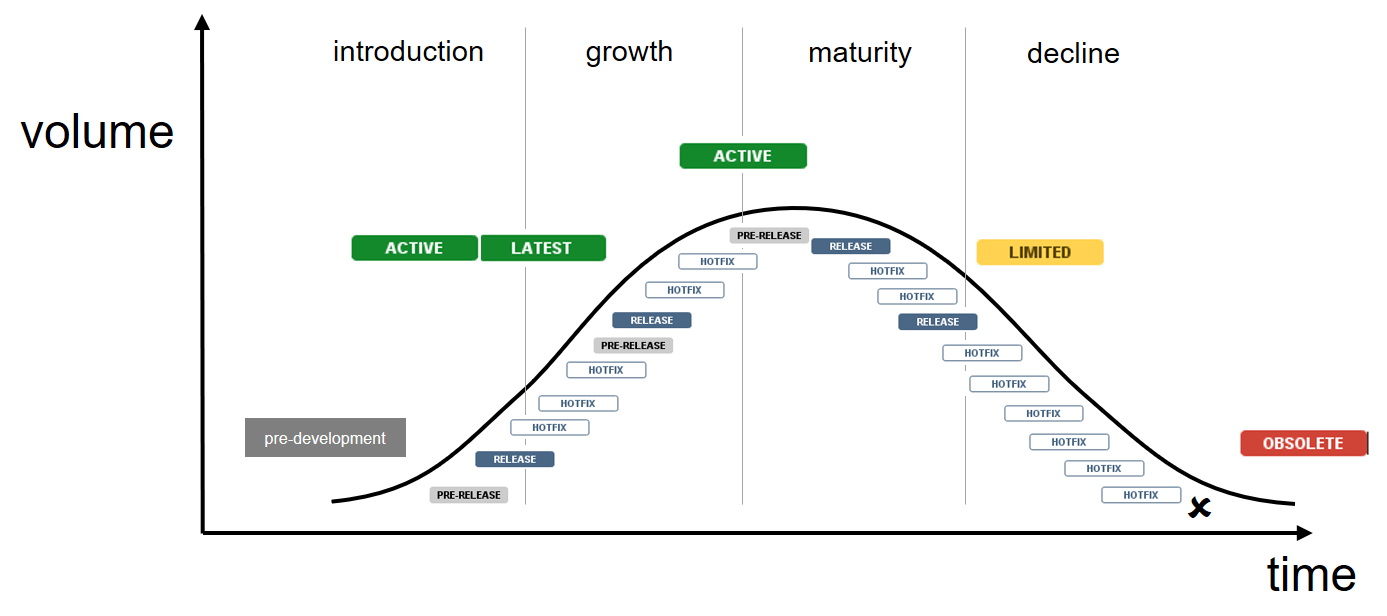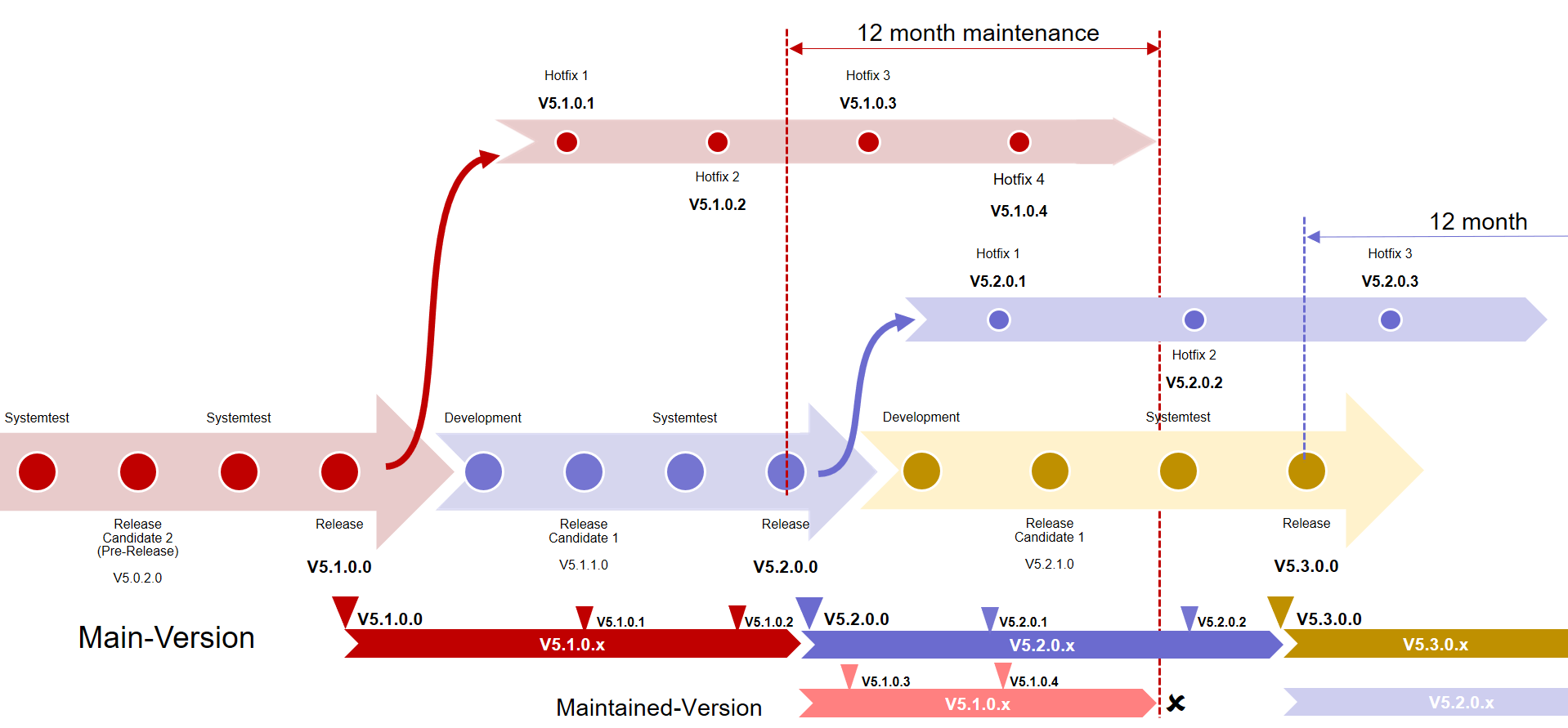Firmware Generation Status Definition and Versioning Scheme
Firmware Generation Status
A particular firmware file/package belongs to a firmware generation, defined by the major version digit.
For example, V5.1.0.0 is a release version, belonging to generation 5.
Each Firmware generation has a firmware status, which reflects the position in life cycle.
The firmware status is subject to change.
Hilscher recommends using firmware in status “active” for new designs, based on the latest technologies. Firmware in status “active” guarantees full performance and greatest set of features.
| Firmware Generation Status | Description | Usage in products |
|---|---|---|
ACTIVELATEST | latest recommended firmware generation, latest technology meet latest certification requirements | design-in and product updates |
ACTIVE | actively maintained and enhanced by new features newer product exists, add value by migration to latest technology | |
LIMITED | not recommended for new designs, bug fixing only, no new features anymore meet latest certification requirements | production only |
OBSOLETE | No development anymore severe bug fixing only successful certification not guaranteed |
figure: firmware life cycle
Firmware Status Transitions
Hilscher announces firmware end of life, i.e. the status transition to “obsolete”, minimum 12 month in advance. Other status transitions have no deadlines.
Transition | Note | Deadlines | Announcement |
Pre-Development | Pre-releases may become available about 3 month prior to the official firmware release | Webpage, public blog, press release | |
Active Latest | When brand new technology becomes available, "active latest" firmware might loose its "latest" status | None | Webpage, public blog |
Active | Typically migration to a new technology is already established, before status changes to limited, Migration to new technology recommended | None Transition to “limited” might be performed when EOL is announced | Webpage, public blog |
Limited | Obsolete firmware can still be used in production, due to grace periods, device certification is still possible for a certain time after end of life | Announcement >=12 month prior to status transition to “obsolete” | Dedicated EOL information to each user, |
Versioning Scheme
A particular firmware file/package belongs to one, out of three possible, version-types:
| Type | Label | Description |
|---|---|---|
| Release Version | RELEASE | Software revision with new features API may differ in relation to other release versions |
| Hotfix Version | HOTFIX | Bugfixing only, no new features same API and same feature set as related release version |
| Pre-Release Version | PRE-RELEASE | Firmware version for evaluation purposes only |
The version type is not a subject to change, in contrast to the status of the firmware generation. A release version, e.g. PROFINET firmware V5.2.0.0, remains a release version, independent of the status of the respective firmware generation.
Each protocol firmware has a 4 digit version number. A dot “.” separates each digit.
Digit | Meaning | Description |
|---|---|---|
A | Major | firmware generation Major differences to other firmware generations |
B | Minor | firmware revision API may differ in relation to other minor revisions |
C | Pre-Release | firmware version for evaluation purposes only Pre-Releases have a C-digit unequal to 0 C is always 0 in official revisions for mass production |
D | Hotfix | Bugfixing, no new features same API and same feature set, as versions with same major and minor revision |
Examples
V 5.2.0.0 release version (new features and different API compared to V5.1.0.x)
V 5.2.0.7 hotfix version of V5.2 (bugfixing only, same features and same API as V5.2.0.x)
V 5.2.1.0 pre-release of upcoming V5.3.0.0 (new features and different API compared to V5.2.0.x) for development purposes only
Major Digit
The major version number defines a firmware generation. Generations differ in SW architecture, feature set and availability for particular target devices. Firmware generations are developed maintained and offered over a long time period of several years. The APIs of different firmware generations are not compatible and might differ significantly. User applications might require adoptions if the used firmware generation is changed.
Minor Digit
The minor version number defines firmware revisions. In the course of the firmware development, Hilscher implements new features and assures conformity to new certification requirements (guarantee successful conformity tests). New revisions are typically released in time periods of several month to once per year. The APIs of different firmware revisions (from the same firmware generation) are very similar, though Hilscher does not guarantee compatibility . In many cases, only new services are extended which may be optionally used in an application. Usually, only minor modification to the user application must be implemented.
Hotfix Digit
Hotfix versions are typically published only for bug-fix purposes, not for release of new features and functionality. The API of hotfix versions is not changed, compared to other versions of the same major.minor version firmware. It is not necessary to adapt the user application if a hotfix version is applied.
Pre-Release Digit
Pre-Release firmware is provided only on request to allow early integration and customer feedback, they are not published officially. Pre-release firmware is intended for development purposes only. It must not be used in mass production.
Maintenance Time Period
Maintained firmware is supplied with bugfixes and conformance related improvements by Hilscher in the form of "Hotfix Versions". The latest revision version of a firmware is always maintained by Hilscher.
If a firmware is replaced by a newer revision, Hilscher guarantees a maintenance time period of 12 month for the previous, replaced firmware revision. 12 month after release of a new revision, maintenance for the previous revision is ultimately ceased. Referring to the figure below, at release of Firmware revision V5.2.0.0 (blue bars) the 12month maintenance period for Firmware revision V5.1.0.0 (red bars) is started. New hotfix versions for V5.1.0.x will be published only until the 12 month maintenance period is expired. I.e. V5.1.0.4 would be the last hotfix version of revision V5.1.0.x. If bugs are discovered after the 12 month maintenance period, these are not fixed in V5.1.0.x anymore, but only in the successor revisions V5.2.0.x and/or V5.3.0.x, etc.
![]() A firmware revision with expired maintenance (no hotfixes offered anymore) is labeld with EXPIRED
A firmware revision with expired maintenance (no hotfixes offered anymore) is labeld with EXPIRED
| Maintenance Status | Label | Description |
|---|---|---|
| within maintenance time period (minimum 12month) | MAINTAINED | hot fix versions for an older firmware revision are offered |
| maintenance time period is expired | EXPIRED | no hotfix versions are offered anymore for an older firmware revision API may differ in relation to other release versions |
figure: development thread

